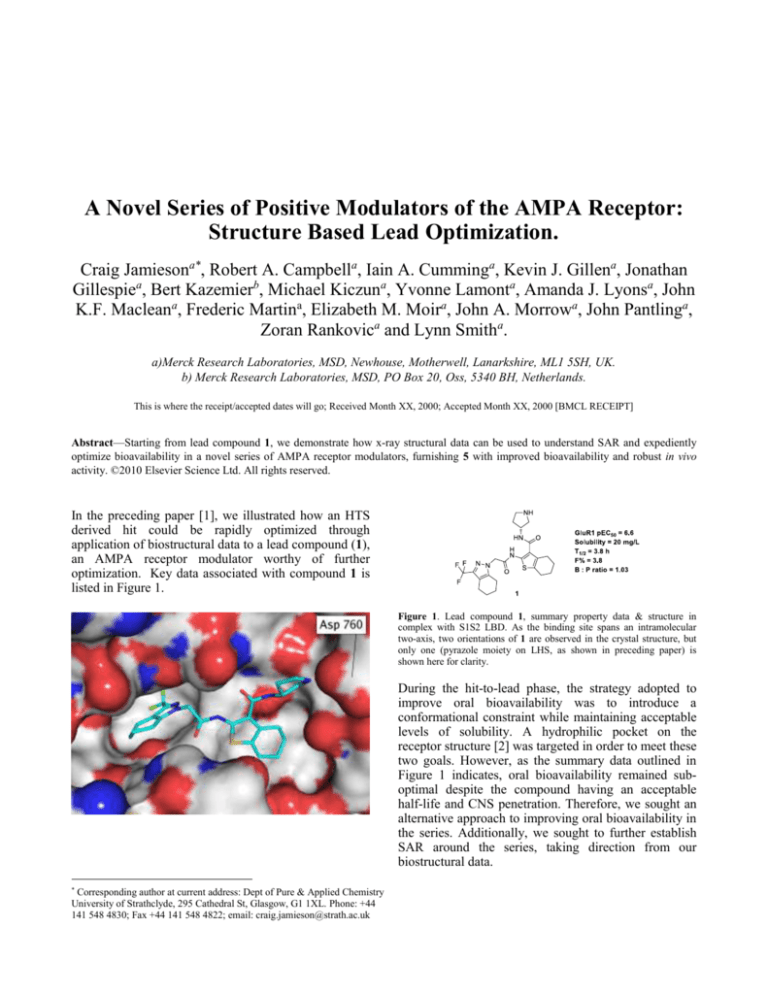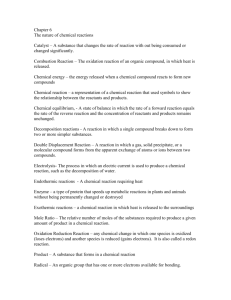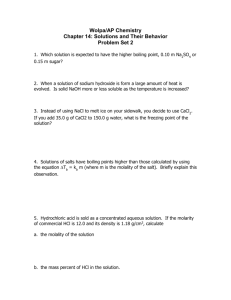
A Novel Series of Positive Modulators of the AMPA Receptor:
Structure Based Lead Optimization.
Craig Jamiesona*, Robert A. Campbella, Iain A. Cumminga, Kevin J. Gillena, Jonathan
Gillespiea, Bert Kazemierb, Michael Kiczuna, Yvonne Lamonta, Amanda J. Lyonsa, John
K.F. Macleana, Frederic Martina, Elizabeth M. Moira, John A. Morrowa, John Pantlinga,
Zoran Rankovica and Lynn Smitha.
a)Merck Research Laboratories, MSD, Newhouse, Motherwell, Lanarkshire, ML1 5SH, UK.
b) Merck Research Laboratories, MSD, PO Box 20, Oss, 5340 BH, Netherlands.
This is where the receipt/accepted dates will go; Received Month XX, 2000; Accepted Month XX, 2000 [BMCL RECEIPT]
Abstract—Starting from lead compound 1, we demonstrate how x-ray structural data can be used to understand SAR and expediently
optimize bioavailability in a novel series of AMPA receptor modulators, furnishing 5 with improved bioavailability and robust in vivo
activity. ©2010 Elsevier Science Ltd. All rights reserved.
In the preceding paper [1], we illustrated how an HTS
derived hit could be rapidly optimized through
application of biostructural data to a lead compound (1),
an AMPA receptor modulator worthy of further
optimization. Key data associated with compound 1 is
listed in Figure 1.
Figure 1. Lead compound 1, summary property data & structure in
complex with S1S2 LBD. As the binding site spans an intramolecular
two-axis, two orientations of 1 are observed in the crystal structure, but
only one (pyrazole moiety on LHS, as shown in preceding paper) is
shown here for clarity.
During the hit-to-lead phase, the strategy adopted to
improve oral bioavailability was to introduce a
conformational constraint while maintaining acceptable
levels of solubility. A hydrophilic pocket on the
receptor structure [2] was targeted in order to meet these
two goals. However, as the summary data outlined in
Figure 1 indicates, oral bioavailability remained suboptimal despite the compound having an acceptable
half-life and CNS penetration. Therefore, we sought an
alternative approach to improving oral bioavailability in
the series. Additionally, we sought to further establish
SAR around the series, taking direction from our
biostructural data.
*
Corresponding author at current address: Dept of Pure & Applied Chemistry
University of Strathclyde, 295 Cathedral St, Glasgow, G1 1XL. Phone: +44
141 548 4830; Fax +44 141 548 4822; email: craig.jamieson@strath.ac.uk
As the mass of our lead compound (495 Da) was
approaching the upper limits of what is generally
regarded as being useful for an oral drug [3], we turned
our attention to how we could produce analogues of
reduced complexity and molecular weight. A key
objective was to retain a high degree of solubility in
these simplified analogues since we anticipated that this
property would be of benefit to bioavailability.[4] From
the available crystal structures, we reasoned that a
suitably sized solubilising group could be appended
either from the pyrazole region of the molecule or
through modification of the external amide. The
strategy adopted is outlined in Figure 2.
Compds
R1
R2
pEC50a
3
H
H
6.1
4
H
Me
6.9
5
H
Et
6.1
6
Me
Me
6.3
7
H
iPr
5.5
8
H
CH2CH2OMe
5.8
9
Et
Et
6.2
10
H
cPr
6.2
11
-CH2CH2-CH26.0
a
Values are means of two experiments performed in duplicate.
Cli < 19 L/min/mg protein, human Cli <12 L/min/mg
protein, solubility = 107 mg/L). Within the series,
tertiary amine derivatives generally exhibited poor
microsomal stability (e.g. 9 rat/human CLi > 270
L/min/mg protein).
Figure 2. Simplification of lead compound 1.
We initially targeted the amide region as a means of
rationalizing our template and sought to introduce an
alcohol moiety to furnish 2. Compared to the progenitor
compound, 2 was equipotent (pEC50 = 6.6) but lacked
sufficient solubility (1 mg/L) and had unacceptable
microsomal stability (rat/human intrinsic clearance, CLi
> 270 L/min/mg protein). Additionally, we attempted
to introduce amine functionality in this region, however,
our attempts to do so were hamstrung by the innate
chemical instability of such species.
We next turned our attention to introduction of amine
functionality off the tetrahydroindazole species.
Modelling based on our crystal structures suggested that
changes to the fused ring system could be tolerated, and
that main-chain atoms of Pro 494 and Ser 729 provided
potential interaction points. This was in contrast to our
previous experience1 with the tetrahydrobenzothiophene
moiety where preservation of the fused ring was
essential to maintain modulatory activity at GluA1. As
Table 1 illustrates, pendant amines were generally well
tolerated with acceptable measured kinetic solubilities
in the range 20 to 100 mg/L.
Further profiling of selected analogues revealed that
secondary amines such as 4 and 5 displayed a good
overall balance of potency, solubility and microsomal
stability (e.g. 4 rat Cli < 12 L/min/mg protein, human
Cli = 33 L/min/mg protein, solubility = 65 mg/L; 5 rat
Having confirmed that introduction of polar
functionality was tolerated in the pyrazole region, we
then sought to establish additional SAR in this area.
From inspection of the crystal structure of 5 bound to
the S1S2 LBD of GluA2 (Figure 3), we concluded that
the hydrophobic interaction made by the trifluoromethyl
group could be approximated by other moieties such as
tert-butyl. To this end, we prepared a series of 3-t-butyl
functionalized pyrazolyl amines shown in Table 2.
Figure 3. X-ray structure of compound 5 in complex with the S1S2J LBD
of GluA2 (Alternate orientation to that in Figure 1, with pyrazole moiety
on RHS). The pendant amine function sits between Pro 494 from one
monomer and Ser 729 from another, and forms a hydrogen bond with the
backbone carbonyl of Ser 729. Residues 727-730 were omitted from the
surface depiction for clarity. Here the main-chain atoms of those residues
are shown as sticks to illustrate the hydrogen bond between 5 and Ser
729.
Table 1. Pyrazole substituted amines.
Table 2. Tert-butylpyrazole substituted amines.
Compds
R1
R2
pEC50a
12
H
Me
6.5
13
Me
Me
6.5
14
H
cPr
5.8
15
H
Et
6.1
16
H
iPr
5.8
a
Values are means of two experiments performed in duplicate.
Again further profiling of selected analogues indicated
that compounds such as 12 had a reasonable combined
profile of GluA1 activity, solubility (79 mg/L) and
microsomal stability (rat Cli = 15 L/min/mg protein;
human Cli = 15 L/min/mg protein). The X-ray
structure of 12 in complex with the S1S2 ligand binding
domain confirmed the binding mode was as anticipated
with the tert-butyl system creating a hydrophobic
interaction with the receptor (Figure 4).
Figure 4. X-ray structure of compound 12 in complex with the S1S2J
LBD of GluA2. The orientation of 12 is as shown in Figure 3. In this case
the pendant amine forms a hydrogen bond with Pro 494.
Previously, we had not examined the role of the central
methylene spacer, and in particular, determined the
effect of extending this linker system on potency at
GluA1. Although relatively close hydrophobic contacts
were made by the distal ends of our modulators with the
receptor, we hypothesized that this could be further
optimized through increasing the length of the central
linker system. A selected number of analogues were
prepared and evaluated against GluA1 for their
modulatory activity as summarized in Table 3.
The resulting activity data suggested the homologated
species were up to ten fold less potent than their
progenitor compounds.
In addition, microsomal
stability was eroded, presumably due to the higher
lipophilicity associated with the compounds (e.g. 17 rat
Cli 49 L/min/mg protein, human Cli 89 L/min/mg
protein).
Table 3. Homologated central linker analogues.
Compds
R1
R2
pEC50a
17
H
Me
5.8
18
H
Et
5.6
19
Et
Et
5.7
a
Values are means of two experiments performed in duplicate.
From the amine derivatives prepared from 3 to 16,
compounds 4, 5 and 12 were advanced to in vivo DMPK
studies to assess oral bioavailability. Table 4 shows a
summary of the key properties for each compound.
Table 4. In vivo pharmacokinetic properties of selected compounds
Compds
T1/2 (h)a
Vss (L/kg)a Clp (mL/min/kg)a
F%b
1
3.8
0.5
2.3
4
4
1.5
2.4
23
15
5
1.1
0.6
15
43
12
1.9
1.1
9
16
a
2 mg/kg i.v. dose Wistar BRL rats; b 10 mg/kg p.o. dose Wistar BRL
rats.
This subset of compounds showed encouraging oral
bioavailability compared to our initial lead 1, with 5 in
particular being most promising. The bioavailability
data prompted us to prepare a limited number of further
analogues of 4 and 5 in order to determine if absorption
could be further enhanced. The crystal structure of
compound 5 prompted us to consider conformational
constraint (20, Figure 5) as we believed a heteroatom
could successfully be incorporated into the
tetrahydroindazole system. Another option explored
was to reduce the H-bond donor count to determine if
this parameter could enhance bioavailability, which led
to the design of 21. Although 20 had acceptable potency
(pEC50 = 6.0) it did not show sufficient microsomal
stability (rat Cli 33 L/min/mg protein, human Cli 57
L/min/mg protein) to merit further progression. While
compound 21 had similar potency to both 5 and 20
(pEC50 = 5.8) and good microsomal stability (rat Cli 19
L/min/mg protein, human Cli 16 L/min/mg protein),
it displayed much higher clearance in vivo (Clp = 43
mL/min/kg), therefore, it was not further progressed.
Figure 5.
Returning to compound 5, further in vitro profiling
indicated the compound was a selective AMPA positive
modulator, with no activity at kainate, NMDA or
GABA. Wider selectivity determination [5] indicated no
off-target activity against a panel of receptors and
channels. Determination of brain to plasma ratio in
Wistar BRL rats gave a value of 0.05 which indicated
modest exposure in the central compartment. However,
testing the compound in vivo showed that 5 gave robust
potentiation of AMPA evoked single unit activity as
measured by electrophysiology in the hippocampus of
anesthetized rats [6], with an MED of 0.3 mg/kg when
dosed intravenously. This mechanistic data gave us
confidence that 5 was capable of modulating AMPA
activity in vivo despite its apparently modest brain
penetration.
Syntheses of the compounds described above are
outlined in Schemes 1 to 3. Compound 2 was prepared
in a 3 step manner from the carboxylic acid 22
(prepared as described in the preceding publication1).
Copper mediated decarboxylation gave the amide 23
followed by Villsmier formylation and subsequent
borohydride reduction furnished 2.
Scheme 2. Reagents and conditions: a) bromoacetyl bromide, Et3N,
CH2Cl2, rt, 71%; b) 3-trifluoromethyl pyrazole or 3-tert-butylpyrazole
derivative, NaH, DMF, 0° to rt, 27-96%; c) NaBH(OAc)3, AcOH,
CH2Cl2, rt, 12-50%; d) 3-chloropropionyl chloride, Et3N, CH2Cl2, rt, 79%.
Scheme 3. Reagents and conditions: a) morpholine, cat. PTSA, PhMe,
reflux, quant.; b) trifluoroacetic anhydride, Et 3N, CH2Cl2, 5 °C to rt;,
quant. c) hydrazine hydrate, EtOH, 5 °C to rt, 43%; d) 25, K2CO3, DMF,
50 °C, 36%; e) TFA/CH2Cl2, rt, 96%.
Scheme 1. Reagents and conditions: a) Cu, quinoline 200 °C, W, 95%;
b) POCl3, DMF, DCE, reflux, 86%; c) NaBH4, THF, rt, 97%.
Compounds 3 to 16 and compound were accessed as
illustrated in Scheme 2. Gewald cyclisation [7] provided
the aminothiophene derivative 24 which could then be
acetylated with using bromoacetyl bromide in the
presence of base. Alkylation of the appropriate pyrazole
system with 25 followed by reductive amination gave 3
to 11 and 12 to 16, respectively. Compound 21 was
accessed using chemistry analogous to that depicted in
Scheme 2 replacing cyanoacetamide with Nmethylcyanoacetamide in the Gewald step.
The homologated analogues 17 to 19 were prepared
using similar methodology shown also in Scheme 2.
Compound 20 was realized utilizing the synthetic
sequence shown in Scheme 3. The requisite
pyrrolopiperidine system 29 was prepared according to
literature methods.[8] Starting from Boc-piperidinone,
enamine 28 was prepared. Subsequent reaction with
trifluoracetic anhydride and trapping of the resulting diketone with hydrazine gave 29. Alkylation of 29 with
intermediate 25 (Scheme 3) followed by acidolysis of
the Boc group provided compound 20.
In summary, this work has demonstrated how Structurebased Drug Design (SBDD) can be exploited within
target families such as ion channels where previously its
application had been hindered. Throughout our
optimization trajectory, a central component has been
the application of SBDD in directing our template
modifications as well as offering key insights into SAR
within the series. Starting from a lead compound 1
which exhibited poor oral bioavailability, we have
demonstrated how this can be optimized to yield a
rationalized entity (5) that has significantly enhanced
bioavailability with retention of receptor potency as
well as promising in vivo activity.
We believe that 5 provides us with a valuable asset in
order to delineate the role of AMPA receptors in
neurological disorders. Additional pharmacological
profiling of 5 is on-going and will be the subject of a
separate publication.
References
1. Preceding paper
2. Armstrong, N.; Sun ,Y.; Chen, G. Q.; Gouaux, E.
Nature 1998, 395, 913. Coordinates and structure factors
have been deposited in the Protein Data Bank for
complexes of compounds 1 (3O6G), 5 (3O6H) and 12
(3O6I).
3. Lipinski, C.A.; Lombardo, F.; Dominy, B.W.; Feeney,
P.J. Adv. Drug Delivery Rev. 1997, 23, 3.
4. Lipinski, C. A. J. Pharm. Tox. Methods 2001, 44,
235.
5. Selectivity profiling against a panel of 80 receptors
and channels carried out by Caliper Life Sciences, 68 Elm
Street, Hopkinton, MA01748 USA; www.caliperls.com
6. Vandergriff, J.; Huff, K.; Bond, A.; Lodge, D..
Neuropharmacology 2001, 40, 1003.
7. Gewald, K.; Schinke, E.; Boettcher, H. Chem. Ber.
1966, 99, 94.
8. Pennell, A. M. K.; Aggen, J. B.; Wright, J. J. K.; Sen,
S.; McMaster, B. E.; Dairaghi, D. J.; Chen, W.; Zhang, P.
U.S. Pat. Appl. Publ. 2006106218, 2006.









